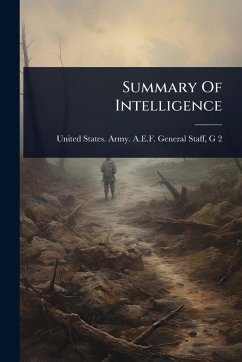
Seeking a Theory of Tactical Intelligence to Support the AirLand Battle
Versandkostenfrei!
Versandfertig in über 4 Wochen
15,99 €
inkl. MwSt.
Weitere Ausgaben:

PAYBACK Punkte
8 °P sammeln!
This study contrasts two opposing theories which have shaped the U.S. Army's tactical intelligence process since 1940. One theory holds that the best kind of tactical intelligence is predictive in nature. The other theory states that tactical intelligence should merely describe the current tactical situation. The monograph evaluates three combat intelligence systems which emerged from these theories during and after World War II. The Intentions System purported to predict enemy actions based upon suspected enemy intentions. The Capabilities System promised to predict enemy action based upon hi...
This study contrasts two opposing theories which have shaped the U.S. Army's tactical intelligence process since 1940. One theory holds that the best kind of tactical intelligence is predictive in nature. The other theory states that tactical intelligence should merely describe the current tactical situation. The monograph evaluates three combat intelligence systems which emerged from these theories during and after World War II. The Intentions System purported to predict enemy actions based upon suspected enemy intentions. The Capabilities System promised to predict enemy action based upon his capabilities. The Descriptive System stated that prediction is irrelevant, and that the decision-maker needs only a clear description of the present battlefield. The monograph draws heavily on observations made by World War II senior commanders, general officer boards, and Army Ground Force Observer teams. From this study one could conclude that: the Army's command and staff planning sequence demands a predictive approach to intelligence, whether prediction is possible or not; predictive intelligence systems, again in use today, hide reality from the decision-maker by constructing estimates based upon successive assumptions; and, when making his decision, the commander is best served by relying on fact rather than assumption. The study concludes that the U.S. Army should discard the predictive theory of tactical intelligence and adopt a descriptive approach. This work has been selected by scholars as being culturally important, and is part of the knowledge base of civilization as we know it. This work was reproduced from the original artifact, and remains as true to the original work as possible. Therefore, you will see the original copyright references, library stamps (as most of these works have been housed in our most important libraries around the world), and other notations in the work. This work is in the public domain in the United States of America, and possibly other nations. Within the United States, you may freely copy and distribute this work, as no entity (individual or corporate) has a copyright on the body of the work. As a reproduction of a historical artifact, this work may contain missing or blurred pages, poor pictures, errant marks, etc. Scholars believe, and we concur, that this work is important enough to be preserved, reproduced, and made generally available to the public. We appreciate your support of the preservation process, and thank you for being an important part of keeping this knowledge alive and relevant.












